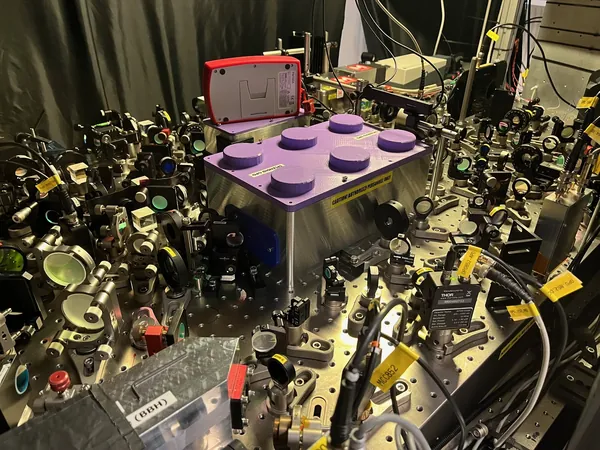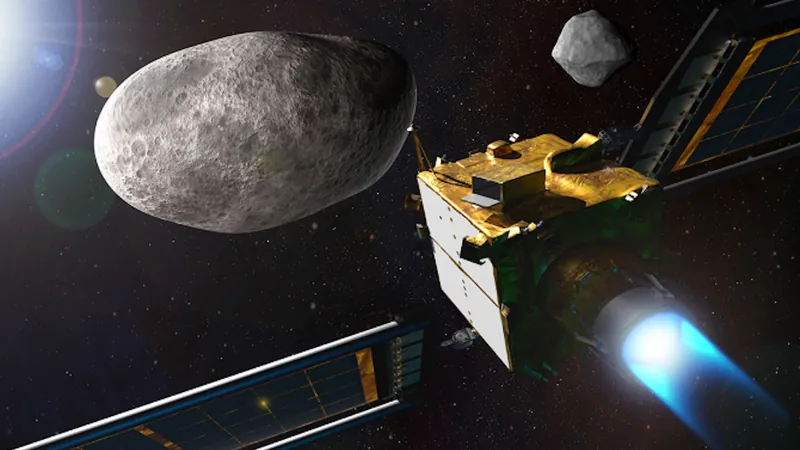
Revolutionizing Quantum Sensing: Scientists Unveil Groundbreaking Tunable System
2025-07-03
Author: Wei Ling
Groundbreaking research from the Niels Bohr Institute at the University of Copenhagen has unveiled a revolutionary tunable system that promises to significantly enhance sensing accuracy across a myriad of technologies, including biomedical diagnostics. This pioneering discovery, published in the prestigious journal Nature, marks a new era in the realm of advanced quantum sensing.
Imagine a technology capable of detecting gravitational waves from the farthest reaches of space while also sensing minute fluctuations within our own bodies. The implications of this research are immense, ranging from everyday optical sensing technologies to cutting-edge applications in medical diagnostics.
Thanks to recent advancements in quantum optics, the sensitivity of these devices is edging closer to what experts define as the standard quantum limit—a threshold constrained by unavoidable noise inherent in measuring at microscopic scales.
To surpass this barrier, scientists must employ sophisticated quantum techniques that nullify or diminish this noise. Techniques involving squeezed light, back-action evasion, and entanglement are now vital components in this toolkit for enhanced sensing.
Back-action noise surfaces when the act of measurement inadvertently disturbs the system being observed, whereas detection noise stems from the intrinsic uncertainty of reading measurement signals.
Entanglement, a quintessential concept differentiating classical from quantum physics, offers the possibility of sensing operations that go beyond the standard quantum limit. Historically demonstrated in microscopic systems like individual atoms and photons, the new system at the NBI breaks new ground by utilizing large-scale entanglement.
In an unprecedented feat, researchers have managed to entangle multiple photons with a large atomic spin ensemble, creating a unique combination of techniques that enables frequency-dependent squeezing—an innovation that allows dynamic quantum noise reduction across a wide frequency band.
This development is essential for applications such as detecting gravitational waves and improving the sensitivity of various sensing technologies. By utilizing squeezed light—characterized by its ability to minimize quantum noise—and a unique 'negative mass' spin system, researchers have achieved a remarkable breakthrough.
Squeezed light can reduce either amplitude or phase noise, but effective broadband quantum noise suppression requires varying squeezing across different frequencies. The innovative technique developed leverages an atomic spin ensemble to adjust the phase of squeezed light depending on its frequency, effectively managing noise.
The spin ensemble also serves a crucial role by flipping the noise sign from positive to negative, enabling the suppression of quantum noise when combined with the sensor's signal. As Professor Eugene Polzik from the Niels Bohr Institute explains, this intricate interaction with two entangled beams of light leads to the detection of a broader range of signals—effectively surpassing the standard quantum sensitivity threshold.
Unlike traditional methods—which necessitate cumbersome and complex optical setups, like the 300-meter optical resonators used in existing gravitational wave detectors such as LIGO and VIRGO—the new system paves the way towards achieving similar performance using a compact tabletop device.
This hybrid quantum network is not only poised for extensive applications in advanced sensing technologies, but it also holds promise for major advancements in biomedical fields. Enhanced sensors could lead to improved magnetic resonance imaging (MRI), earlier detection of neurological disorders, and more sensitive biosensors for health diagnostics.
Moreover, the research team highlighted the potential for enhancing gravitational wave detectors, enabling the detection of elusive ripples in spacetime—signals from cataclysmic cosmic events like black hole mergers and neutron star collisions. Such breakthroughs offer vital insights into the universe's formation processes.
The implications extend beyond sensing. The architecture of this newly developed system opens new avenues for quantum communication and computation, paving the path for advances in secure long-distance communications and quantum memory systems in quantum networks. The versatility of this technology across multiple quantum domains is indeed promising.






 Brasil (PT)
Brasil (PT)
 Canada (EN)
Canada (EN)
 Chile (ES)
Chile (ES)
 Česko (CS)
Česko (CS)
 대한민국 (KO)
대한민국 (KO)
 España (ES)
España (ES)
 France (FR)
France (FR)
 Hong Kong (EN)
Hong Kong (EN)
 Italia (IT)
Italia (IT)
 日本 (JA)
日本 (JA)
 Magyarország (HU)
Magyarország (HU)
 Norge (NO)
Norge (NO)
 Polska (PL)
Polska (PL)
 Schweiz (DE)
Schweiz (DE)
 Singapore (EN)
Singapore (EN)
 Sverige (SV)
Sverige (SV)
 Suomi (FI)
Suomi (FI)
 Türkiye (TR)
Türkiye (TR)
 الإمارات العربية المتحدة (AR)
الإمارات العربية المتحدة (AR)